Project Management: Goals, Scope, and Project Overview Report
VerifiedAdded on 2021/04/17
|10
|1772
|40
Project
AI Summary
This project management assignment addresses the repair of storage tanks in Western Australia. The project focuses on repairing three tanks with detected leakage, aiming to prevent the collapse of 30% of the company's unleaded petrol storage capacity. The assignment outlines the project's goals, including repairing, cleaning, and repainting the tanks, while using a waterfall project methodology. It details the project scope, including a scope statement, stakeholder identification (project manager, HSE manager, facility, revenue division, and team members), project deliverables (steel patches, cleaning, and painting), and acceptance criteria. The project overview describes the implementation process, project life cycle (requirement analysis, implementation, cleaning, handover, resource release, and client sign-off), and success criteria (budget, leakage resolution, cleaning, and accident prevention). The report provides a comprehensive analysis of the project's planning, execution, and control phases, highlighting the sequential approach and stakeholder involvement.
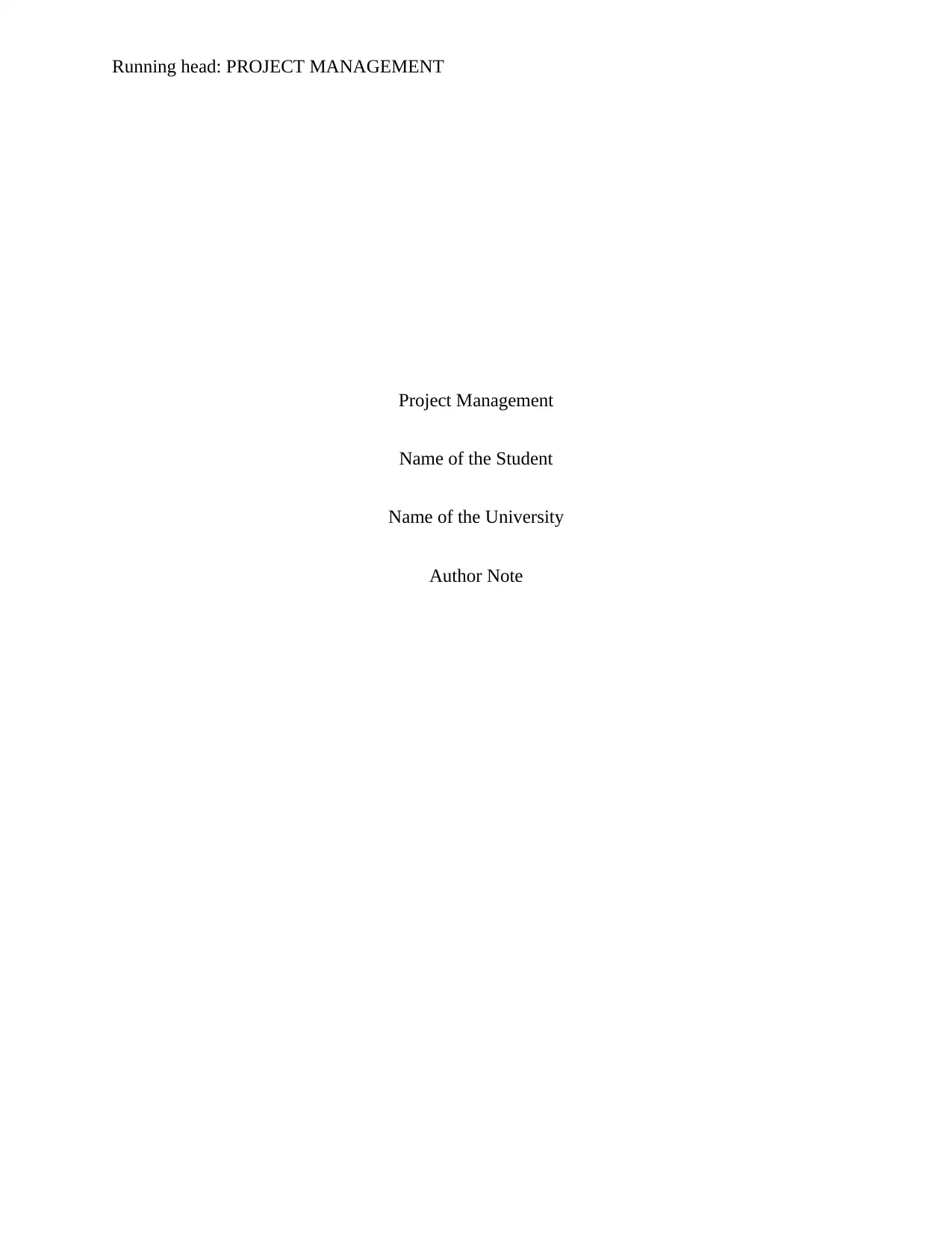
Running head: PROJECT MANAGEMENT
Project Management
Name of the Student
Name of the University
Author Note
Project Management
Name of the Student
Name of the University
Author Note
Paraphrase This Document
Need a fresh take? Get an instant paraphrase of this document with our AI Paraphraser
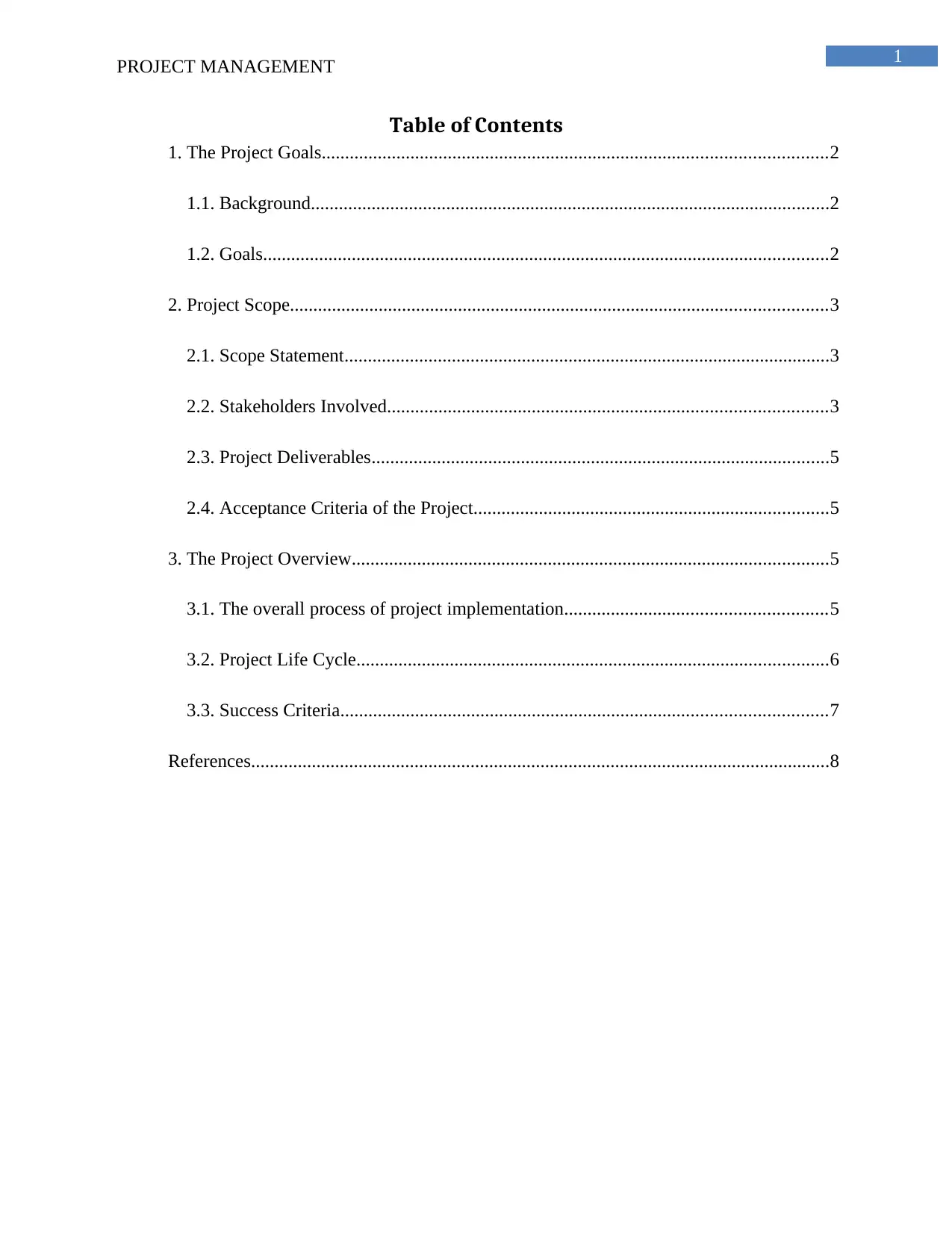
1
PROJECT MANAGEMENT
Table of Contents
1. The Project Goals............................................................................................................2
1.1. Background...............................................................................................................2
1.2. Goals.........................................................................................................................2
2. Project Scope...................................................................................................................3
2.1. Scope Statement........................................................................................................3
2.2. Stakeholders Involved..............................................................................................3
2.3. Project Deliverables..................................................................................................5
2.4. Acceptance Criteria of the Project............................................................................5
3. The Project Overview......................................................................................................5
3.1. The overall process of project implementation........................................................5
3.2. Project Life Cycle.....................................................................................................6
3.3. Success Criteria........................................................................................................7
References............................................................................................................................8
PROJECT MANAGEMENT
Table of Contents
1. The Project Goals............................................................................................................2
1.1. Background...............................................................................................................2
1.2. Goals.........................................................................................................................2
2. Project Scope...................................................................................................................3
2.1. Scope Statement........................................................................................................3
2.2. Stakeholders Involved..............................................................................................3
2.3. Project Deliverables..................................................................................................5
2.4. Acceptance Criteria of the Project............................................................................5
3. The Project Overview......................................................................................................5
3.1. The overall process of project implementation........................................................5
3.2. Project Life Cycle.....................................................................................................6
3.3. Success Criteria........................................................................................................7
References............................................................................................................................8
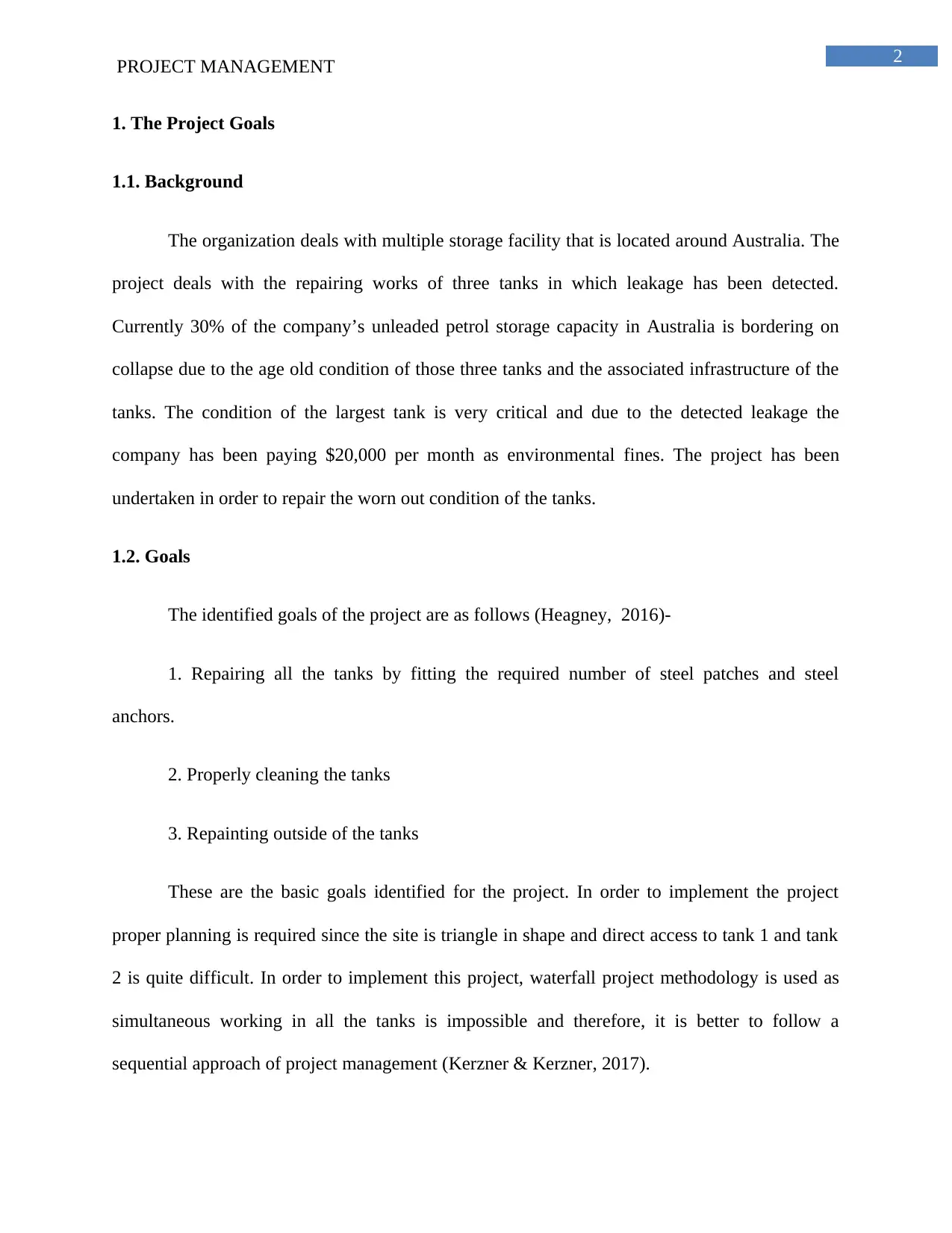
2
PROJECT MANAGEMENT
1. The Project Goals
1.1. Background
The organization deals with multiple storage facility that is located around Australia. The
project deals with the repairing works of three tanks in which leakage has been detected.
Currently 30% of the company’s unleaded petrol storage capacity in Australia is bordering on
collapse due to the age old condition of those three tanks and the associated infrastructure of the
tanks. The condition of the largest tank is very critical and due to the detected leakage the
company has been paying $20,000 per month as environmental fines. The project has been
undertaken in order to repair the worn out condition of the tanks.
1.2. Goals
The identified goals of the project are as follows (Heagney, 2016)-
1. Repairing all the tanks by fitting the required number of steel patches and steel
anchors.
2. Properly cleaning the tanks
3. Repainting outside of the tanks
These are the basic goals identified for the project. In order to implement the project
proper planning is required since the site is triangle in shape and direct access to tank 1 and tank
2 is quite difficult. In order to implement this project, waterfall project methodology is used as
simultaneous working in all the tanks is impossible and therefore, it is better to follow a
sequential approach of project management (Kerzner & Kerzner, 2017).
PROJECT MANAGEMENT
1. The Project Goals
1.1. Background
The organization deals with multiple storage facility that is located around Australia. The
project deals with the repairing works of three tanks in which leakage has been detected.
Currently 30% of the company’s unleaded petrol storage capacity in Australia is bordering on
collapse due to the age old condition of those three tanks and the associated infrastructure of the
tanks. The condition of the largest tank is very critical and due to the detected leakage the
company has been paying $20,000 per month as environmental fines. The project has been
undertaken in order to repair the worn out condition of the tanks.
1.2. Goals
The identified goals of the project are as follows (Heagney, 2016)-
1. Repairing all the tanks by fitting the required number of steel patches and steel
anchors.
2. Properly cleaning the tanks
3. Repainting outside of the tanks
These are the basic goals identified for the project. In order to implement the project
proper planning is required since the site is triangle in shape and direct access to tank 1 and tank
2 is quite difficult. In order to implement this project, waterfall project methodology is used as
simultaneous working in all the tanks is impossible and therefore, it is better to follow a
sequential approach of project management (Kerzner & Kerzner, 2017).
⊘ This is a preview!⊘
Do you want full access?
Subscribe today to unlock all pages.

Trusted by 1+ million students worldwide
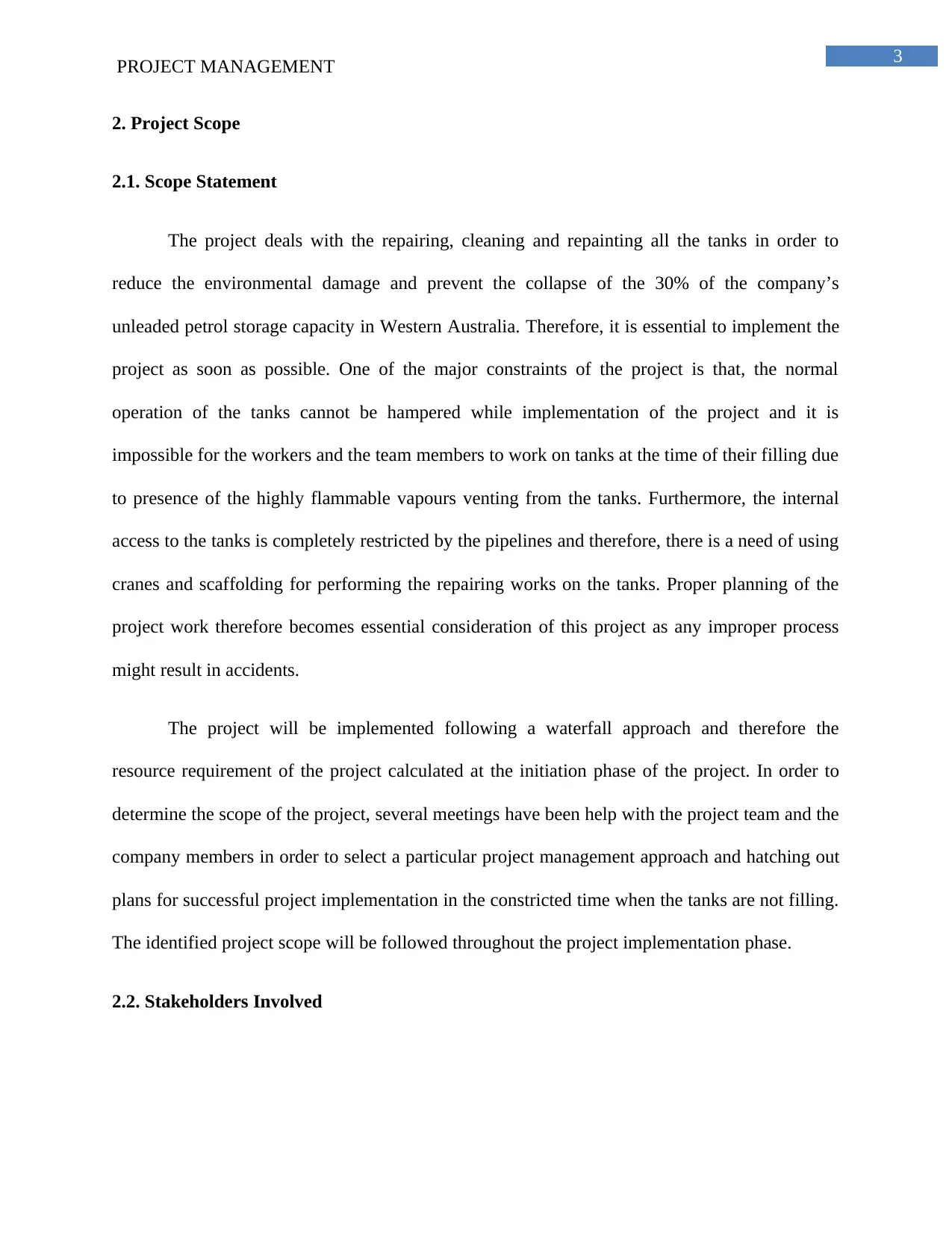
3
PROJECT MANAGEMENT
2. Project Scope
2.1. Scope Statement
The project deals with the repairing, cleaning and repainting all the tanks in order to
reduce the environmental damage and prevent the collapse of the 30% of the company’s
unleaded petrol storage capacity in Western Australia. Therefore, it is essential to implement the
project as soon as possible. One of the major constraints of the project is that, the normal
operation of the tanks cannot be hampered while implementation of the project and it is
impossible for the workers and the team members to work on tanks at the time of their filling due
to presence of the highly flammable vapours venting from the tanks. Furthermore, the internal
access to the tanks is completely restricted by the pipelines and therefore, there is a need of using
cranes and scaffolding for performing the repairing works on the tanks. Proper planning of the
project work therefore becomes essential consideration of this project as any improper process
might result in accidents.
The project will be implemented following a waterfall approach and therefore the
resource requirement of the project calculated at the initiation phase of the project. In order to
determine the scope of the project, several meetings have been help with the project team and the
company members in order to select a particular project management approach and hatching out
plans for successful project implementation in the constricted time when the tanks are not filling.
The identified project scope will be followed throughout the project implementation phase.
2.2. Stakeholders Involved
PROJECT MANAGEMENT
2. Project Scope
2.1. Scope Statement
The project deals with the repairing, cleaning and repainting all the tanks in order to
reduce the environmental damage and prevent the collapse of the 30% of the company’s
unleaded petrol storage capacity in Western Australia. Therefore, it is essential to implement the
project as soon as possible. One of the major constraints of the project is that, the normal
operation of the tanks cannot be hampered while implementation of the project and it is
impossible for the workers and the team members to work on tanks at the time of their filling due
to presence of the highly flammable vapours venting from the tanks. Furthermore, the internal
access to the tanks is completely restricted by the pipelines and therefore, there is a need of using
cranes and scaffolding for performing the repairing works on the tanks. Proper planning of the
project work therefore becomes essential consideration of this project as any improper process
might result in accidents.
The project will be implemented following a waterfall approach and therefore the
resource requirement of the project calculated at the initiation phase of the project. In order to
determine the scope of the project, several meetings have been help with the project team and the
company members in order to select a particular project management approach and hatching out
plans for successful project implementation in the constricted time when the tanks are not filling.
The identified project scope will be followed throughout the project implementation phase.
2.2. Stakeholders Involved
Paraphrase This Document
Need a fresh take? Get an instant paraphrase of this document with our AI Paraphraser
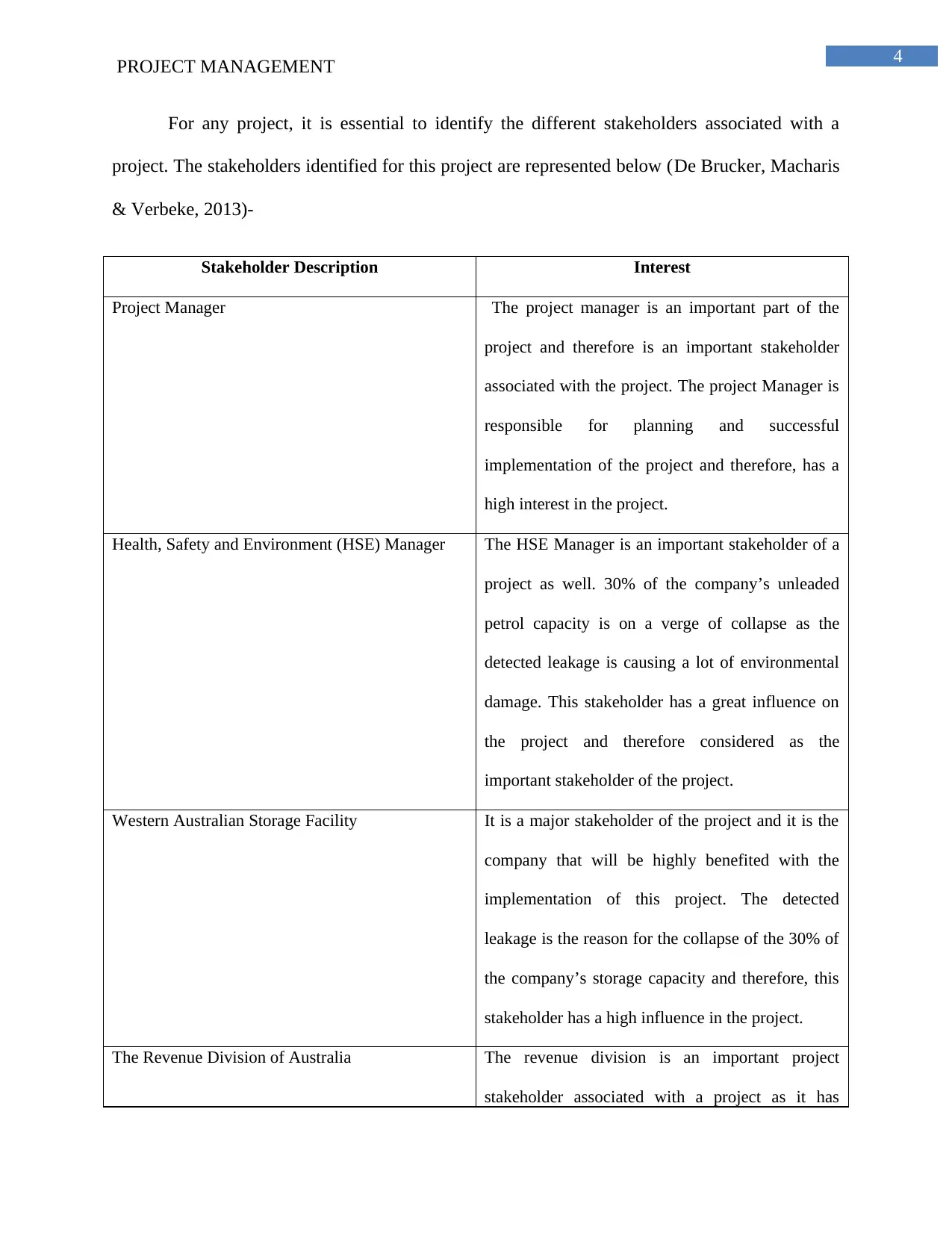
4
PROJECT MANAGEMENT
For any project, it is essential to identify the different stakeholders associated with a
project. The stakeholders identified for this project are represented below (De Brucker, Macharis
& Verbeke, 2013)-
Stakeholder Description Interest
Project Manager The project manager is an important part of the
project and therefore is an important stakeholder
associated with the project. The project Manager is
responsible for planning and successful
implementation of the project and therefore, has a
high interest in the project.
Health, Safety and Environment (HSE) Manager The HSE Manager is an important stakeholder of a
project as well. 30% of the company’s unleaded
petrol capacity is on a verge of collapse as the
detected leakage is causing a lot of environmental
damage. This stakeholder has a great influence on
the project and therefore considered as the
important stakeholder of the project.
Western Australian Storage Facility It is a major stakeholder of the project and it is the
company that will be highly benefited with the
implementation of this project. The detected
leakage is the reason for the collapse of the 30% of
the company’s storage capacity and therefore, this
stakeholder has a high influence in the project.
The Revenue Division of Australia The revenue division is an important project
stakeholder associated with a project as it has
PROJECT MANAGEMENT
For any project, it is essential to identify the different stakeholders associated with a
project. The stakeholders identified for this project are represented below (De Brucker, Macharis
& Verbeke, 2013)-
Stakeholder Description Interest
Project Manager The project manager is an important part of the
project and therefore is an important stakeholder
associated with the project. The project Manager is
responsible for planning and successful
implementation of the project and therefore, has a
high interest in the project.
Health, Safety and Environment (HSE) Manager The HSE Manager is an important stakeholder of a
project as well. 30% of the company’s unleaded
petrol capacity is on a verge of collapse as the
detected leakage is causing a lot of environmental
damage. This stakeholder has a great influence on
the project and therefore considered as the
important stakeholder of the project.
Western Australian Storage Facility It is a major stakeholder of the project and it is the
company that will be highly benefited with the
implementation of this project. The detected
leakage is the reason for the collapse of the 30% of
the company’s storage capacity and therefore, this
stakeholder has a high influence in the project.
The Revenue Division of Australia The revenue division is an important project
stakeholder associated with a project as it has
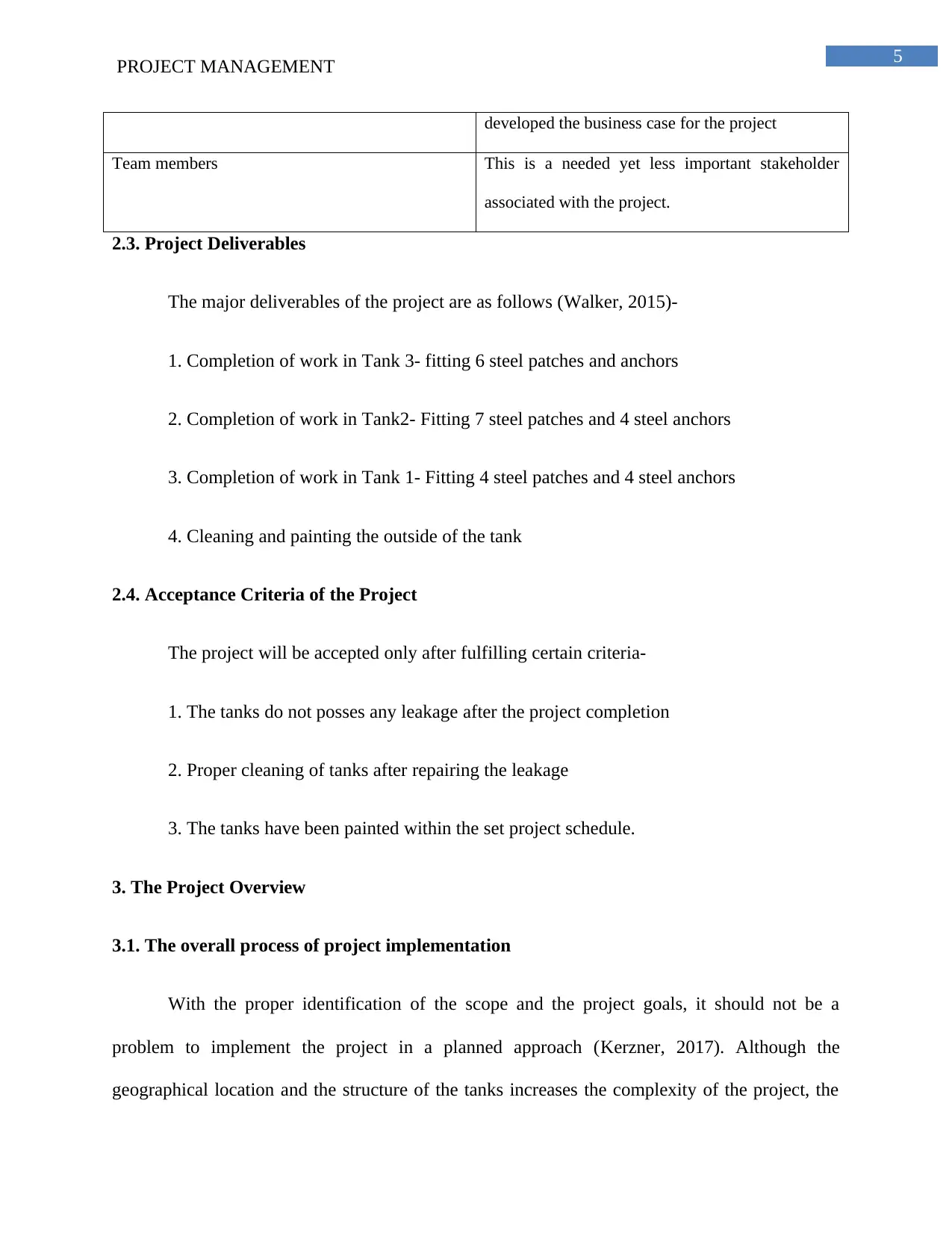
5
PROJECT MANAGEMENT
developed the business case for the project
Team members This is a needed yet less important stakeholder
associated with the project.
2.3. Project Deliverables
The major deliverables of the project are as follows (Walker, 2015)-
1. Completion of work in Tank 3- fitting 6 steel patches and anchors
2. Completion of work in Tank2- Fitting 7 steel patches and 4 steel anchors
3. Completion of work in Tank 1- Fitting 4 steel patches and 4 steel anchors
4. Cleaning and painting the outside of the tank
2.4. Acceptance Criteria of the Project
The project will be accepted only after fulfilling certain criteria-
1. The tanks do not posses any leakage after the project completion
2. Proper cleaning of tanks after repairing the leakage
3. The tanks have been painted within the set project schedule.
3. The Project Overview
3.1. The overall process of project implementation
With the proper identification of the scope and the project goals, it should not be a
problem to implement the project in a planned approach (Kerzner, 2017). Although the
geographical location and the structure of the tanks increases the complexity of the project, the
PROJECT MANAGEMENT
developed the business case for the project
Team members This is a needed yet less important stakeholder
associated with the project.
2.3. Project Deliverables
The major deliverables of the project are as follows (Walker, 2015)-
1. Completion of work in Tank 3- fitting 6 steel patches and anchors
2. Completion of work in Tank2- Fitting 7 steel patches and 4 steel anchors
3. Completion of work in Tank 1- Fitting 4 steel patches and 4 steel anchors
4. Cleaning and painting the outside of the tank
2.4. Acceptance Criteria of the Project
The project will be accepted only after fulfilling certain criteria-
1. The tanks do not posses any leakage after the project completion
2. Proper cleaning of tanks after repairing the leakage
3. The tanks have been painted within the set project schedule.
3. The Project Overview
3.1. The overall process of project implementation
With the proper identification of the scope and the project goals, it should not be a
problem to implement the project in a planned approach (Kerzner, 2017). Although the
geographical location and the structure of the tanks increases the complexity of the project, the
⊘ This is a preview!⊘
Do you want full access?
Subscribe today to unlock all pages.

Trusted by 1+ million students worldwide
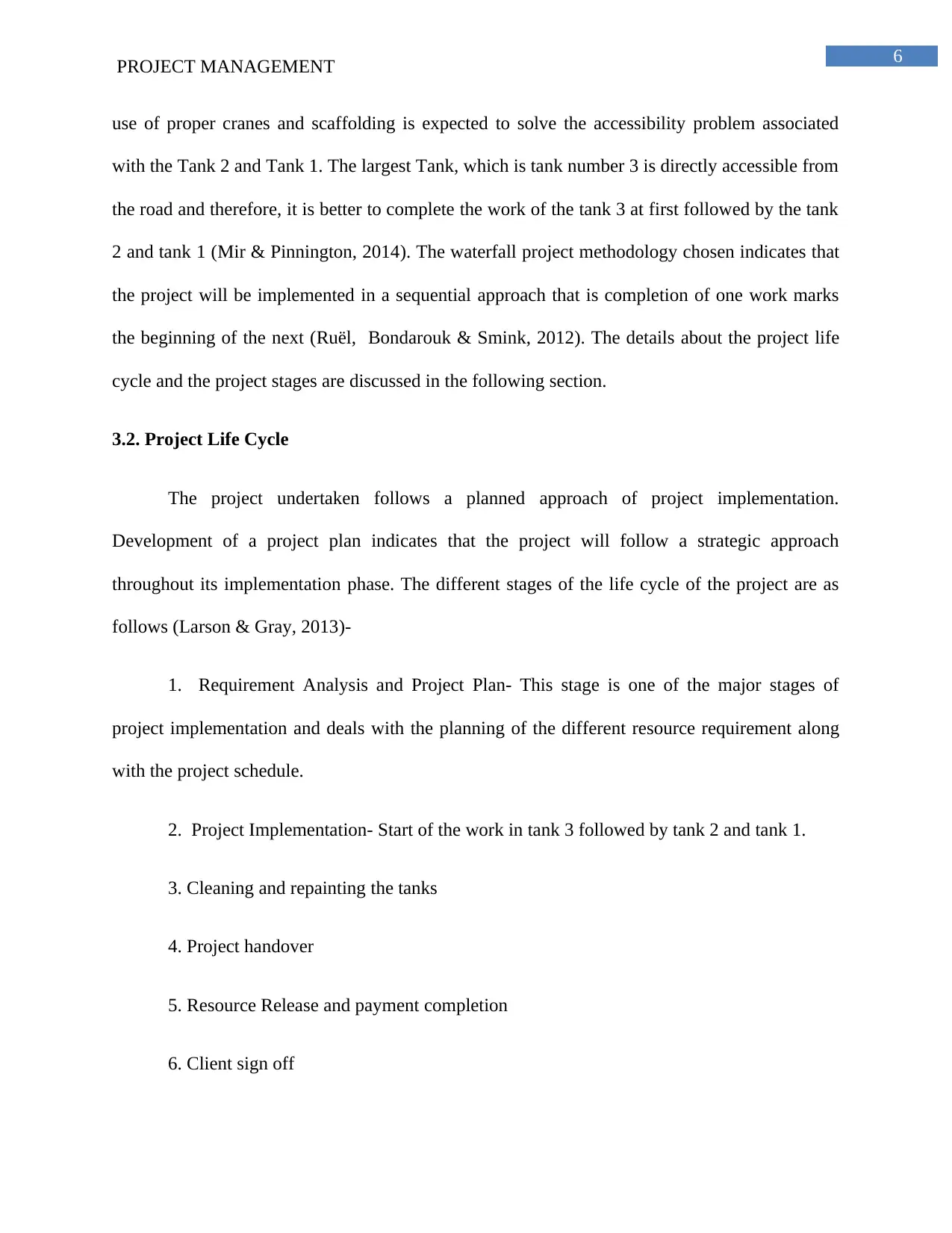
6
PROJECT MANAGEMENT
use of proper cranes and scaffolding is expected to solve the accessibility problem associated
with the Tank 2 and Tank 1. The largest Tank, which is tank number 3 is directly accessible from
the road and therefore, it is better to complete the work of the tank 3 at first followed by the tank
2 and tank 1 (Mir & Pinnington, 2014). The waterfall project methodology chosen indicates that
the project will be implemented in a sequential approach that is completion of one work marks
the beginning of the next (Ruël, Bondarouk & Smink, 2012). The details about the project life
cycle and the project stages are discussed in the following section.
3.2. Project Life Cycle
The project undertaken follows a planned approach of project implementation.
Development of a project plan indicates that the project will follow a strategic approach
throughout its implementation phase. The different stages of the life cycle of the project are as
follows (Larson & Gray, 2013)-
1. Requirement Analysis and Project Plan- This stage is one of the major stages of
project implementation and deals with the planning of the different resource requirement along
with the project schedule.
2. Project Implementation- Start of the work in tank 3 followed by tank 2 and tank 1.
3. Cleaning and repainting the tanks
4. Project handover
5. Resource Release and payment completion
6. Client sign off
PROJECT MANAGEMENT
use of proper cranes and scaffolding is expected to solve the accessibility problem associated
with the Tank 2 and Tank 1. The largest Tank, which is tank number 3 is directly accessible from
the road and therefore, it is better to complete the work of the tank 3 at first followed by the tank
2 and tank 1 (Mir & Pinnington, 2014). The waterfall project methodology chosen indicates that
the project will be implemented in a sequential approach that is completion of one work marks
the beginning of the next (Ruël, Bondarouk & Smink, 2012). The details about the project life
cycle and the project stages are discussed in the following section.
3.2. Project Life Cycle
The project undertaken follows a planned approach of project implementation.
Development of a project plan indicates that the project will follow a strategic approach
throughout its implementation phase. The different stages of the life cycle of the project are as
follows (Larson & Gray, 2013)-
1. Requirement Analysis and Project Plan- This stage is one of the major stages of
project implementation and deals with the planning of the different resource requirement along
with the project schedule.
2. Project Implementation- Start of the work in tank 3 followed by tank 2 and tank 1.
3. Cleaning and repainting the tanks
4. Project handover
5. Resource Release and payment completion
6. Client sign off
Paraphrase This Document
Need a fresh take? Get an instant paraphrase of this document with our AI Paraphraser
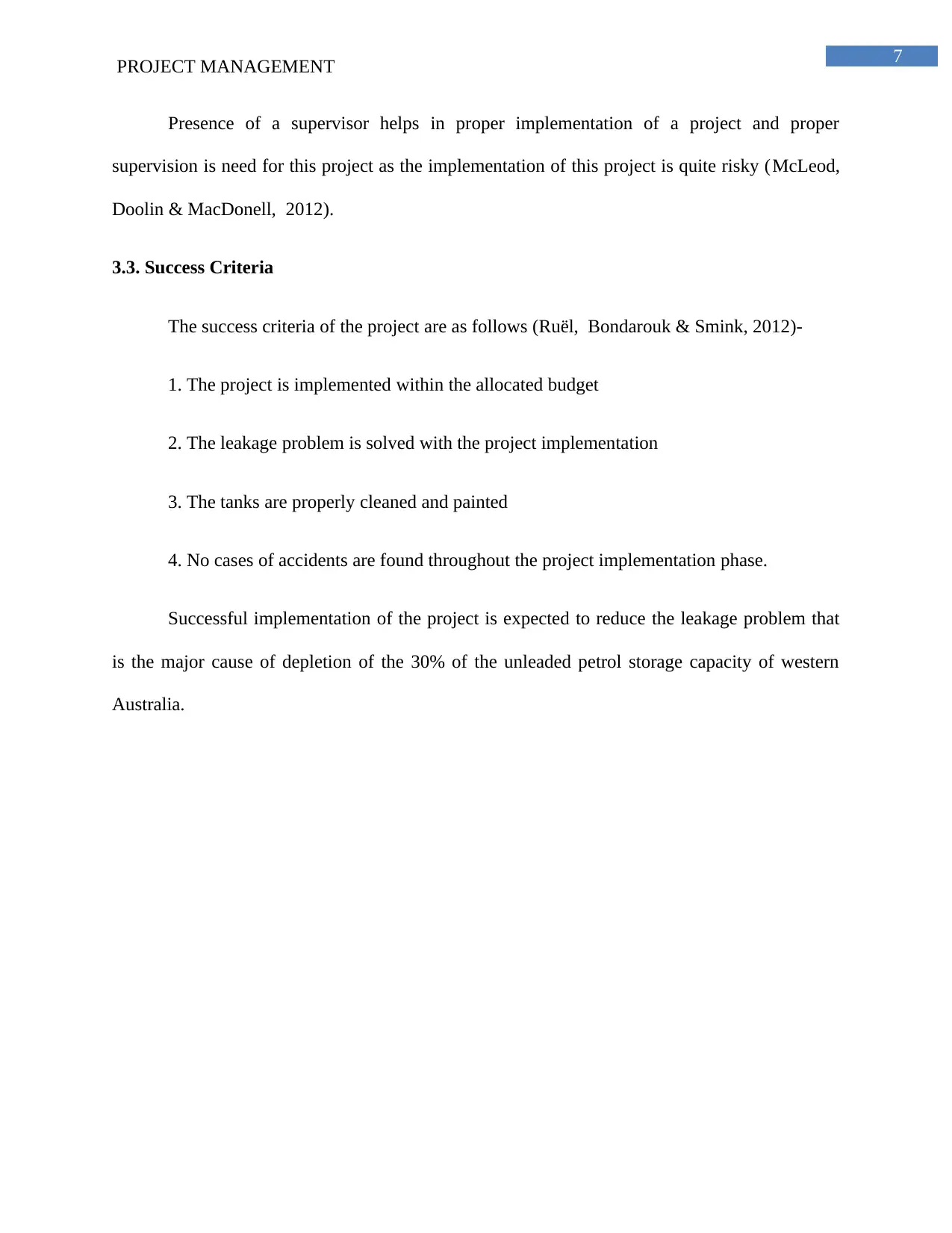
7
PROJECT MANAGEMENT
Presence of a supervisor helps in proper implementation of a project and proper
supervision is need for this project as the implementation of this project is quite risky (McLeod,
Doolin & MacDonell, 2012).
3.3. Success Criteria
The success criteria of the project are as follows (Ruël, Bondarouk & Smink, 2012)-
1. The project is implemented within the allocated budget
2. The leakage problem is solved with the project implementation
3. The tanks are properly cleaned and painted
4. No cases of accidents are found throughout the project implementation phase.
Successful implementation of the project is expected to reduce the leakage problem that
is the major cause of depletion of the 30% of the unleaded petrol storage capacity of western
Australia.
PROJECT MANAGEMENT
Presence of a supervisor helps in proper implementation of a project and proper
supervision is need for this project as the implementation of this project is quite risky (McLeod,
Doolin & MacDonell, 2012).
3.3. Success Criteria
The success criteria of the project are as follows (Ruël, Bondarouk & Smink, 2012)-
1. The project is implemented within the allocated budget
2. The leakage problem is solved with the project implementation
3. The tanks are properly cleaned and painted
4. No cases of accidents are found throughout the project implementation phase.
Successful implementation of the project is expected to reduce the leakage problem that
is the major cause of depletion of the 30% of the unleaded petrol storage capacity of western
Australia.
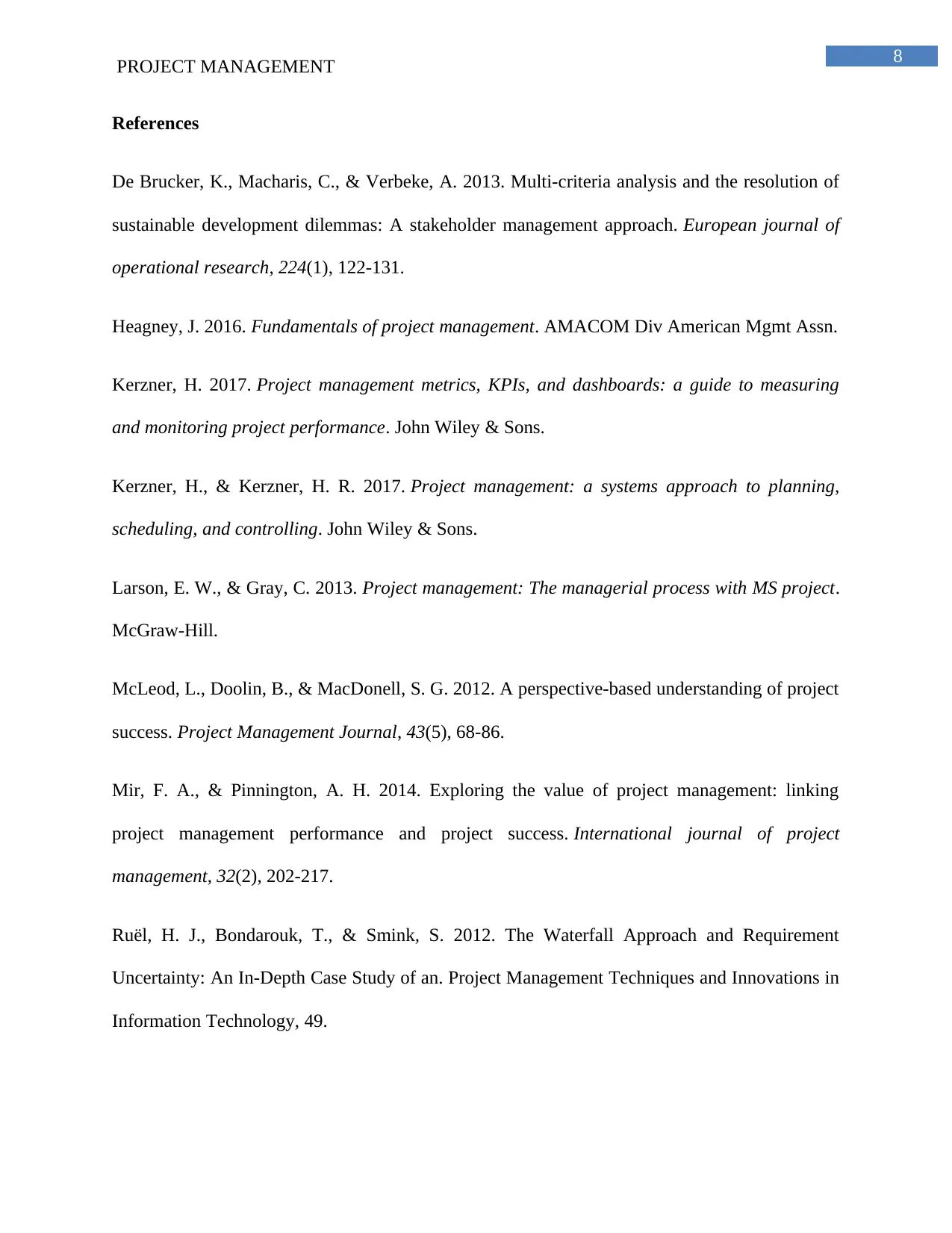
8
PROJECT MANAGEMENT
References
De Brucker, K., Macharis, C., & Verbeke, A. 2013. Multi-criteria analysis and the resolution of
sustainable development dilemmas: A stakeholder management approach. European journal of
operational research, 224(1), 122-131.
Heagney, J. 2016. Fundamentals of project management. AMACOM Div American Mgmt Assn.
Kerzner, H. 2017. Project management metrics, KPIs, and dashboards: a guide to measuring
and monitoring project performance. John Wiley & Sons.
Kerzner, H., & Kerzner, H. R. 2017. Project management: a systems approach to planning,
scheduling, and controlling. John Wiley & Sons.
Larson, E. W., & Gray, C. 2013. Project management: The managerial process with MS project.
McGraw-Hill.
McLeod, L., Doolin, B., & MacDonell, S. G. 2012. A perspective‐based understanding of project
success. Project Management Journal, 43(5), 68-86.
Mir, F. A., & Pinnington, A. H. 2014. Exploring the value of project management: linking
project management performance and project success. International journal of project
management, 32(2), 202-217.
Ruël, H. J., Bondarouk, T., & Smink, S. 2012. The Waterfall Approach and Requirement
Uncertainty: An In-Depth Case Study of an. Project Management Techniques and Innovations in
Information Technology, 49.
PROJECT MANAGEMENT
References
De Brucker, K., Macharis, C., & Verbeke, A. 2013. Multi-criteria analysis and the resolution of
sustainable development dilemmas: A stakeholder management approach. European journal of
operational research, 224(1), 122-131.
Heagney, J. 2016. Fundamentals of project management. AMACOM Div American Mgmt Assn.
Kerzner, H. 2017. Project management metrics, KPIs, and dashboards: a guide to measuring
and monitoring project performance. John Wiley & Sons.
Kerzner, H., & Kerzner, H. R. 2017. Project management: a systems approach to planning,
scheduling, and controlling. John Wiley & Sons.
Larson, E. W., & Gray, C. 2013. Project management: The managerial process with MS project.
McGraw-Hill.
McLeod, L., Doolin, B., & MacDonell, S. G. 2012. A perspective‐based understanding of project
success. Project Management Journal, 43(5), 68-86.
Mir, F. A., & Pinnington, A. H. 2014. Exploring the value of project management: linking
project management performance and project success. International journal of project
management, 32(2), 202-217.
Ruël, H. J., Bondarouk, T., & Smink, S. 2012. The Waterfall Approach and Requirement
Uncertainty: An In-Depth Case Study of an. Project Management Techniques and Innovations in
Information Technology, 49.
⊘ This is a preview!⊘
Do you want full access?
Subscribe today to unlock all pages.

Trusted by 1+ million students worldwide
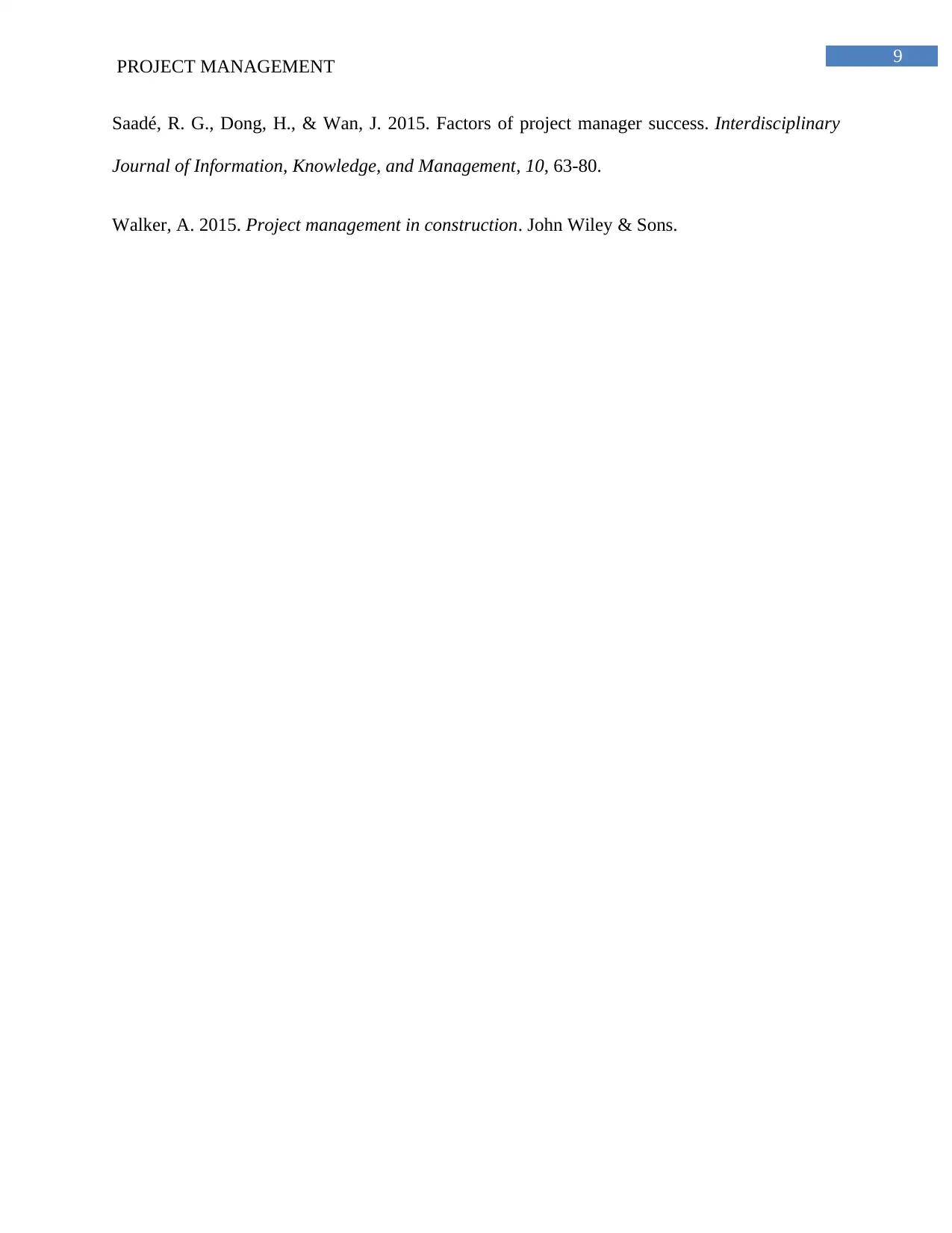
9
PROJECT MANAGEMENT
Saadé, R. G., Dong, H., & Wan, J. 2015. Factors of project manager success. Interdisciplinary
Journal of Information, Knowledge, and Management, 10, 63-80.
Walker, A. 2015. Project management in construction. John Wiley & Sons.
PROJECT MANAGEMENT
Saadé, R. G., Dong, H., & Wan, J. 2015. Factors of project manager success. Interdisciplinary
Journal of Information, Knowledge, and Management, 10, 63-80.
Walker, A. 2015. Project management in construction. John Wiley & Sons.
1 out of 10
Related Documents
Your All-in-One AI-Powered Toolkit for Academic Success.
+13062052269
info@desklib.com
Available 24*7 on WhatsApp / Email
![[object Object]](/_next/static/media/star-bottom.7253800d.svg)
Unlock your academic potential
Copyright © 2020–2025 A2Z Services. All Rights Reserved. Developed and managed by ZUCOL.





